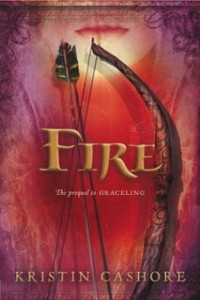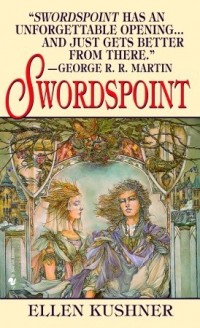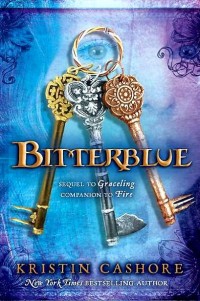Heteronormativity, fantasy, and Bitterblue - Part 2
Welcome back to my two-part discussion of heteronormativity, fantasy, and Kristin Cashore's Bitterblue! Part 1 is here in case you need to refresh your memory. Picking up right from where I left off yesterday, I was about to tackle this question: Is it believable to have same-sex relationships in a medieval-esque fantasy world? SPOILER WARNING: Spoilers for Bitterblue by Kristin Cashore (particularly regarding Raffin) and Swordspoint by Ellen Kushner (though relatively vague spoilers) follow!
Anyone who has read my novels should know that I believe YES, it can be totally believable to have same-sex relationships in a fantasy novel. BUT — and there's a big but here — the world in which same-sex relationships exist must be carefully constructed. Because the average reader of today's fiction lives in the real world in which the vast majority of people do not believe that gay people could live happy lives during the Middle Ages, ((Bearing in mind that I'm using the word "gay" here as shorthand to indicate someone involved in a same-sex sexual relationship. Modern sexual identities as we understand them were not present in the European Middle Ages.)) a fantasy novel set in a medieval-type world has to deal with two big hurdles if it's to include same-sex characters who aren't oppressed.
The first hurdle is getting readers to believe that gay characters could exist at all in this kind of world.
I know that might sound crazy, especially when you're talking about fantasy fiction, which includes elves, dwarves, giants, dragons, and magic (among other things). But I personally have been confronted by people telling me they found the existence of happy gay people to be unbelievable in a fantasy novel. In response, I've replied, "So you're saying you think fairies are more believable than gay people?" (For some people: Yes.)
The fact is, there is a long, long history of secondary world fantasy that completely ignores the possibility of gay people. So most fantasy readers are used to fantasy worlds that include NO gay people. Not one single gay person, much several gay couples as exist in Bitterblue. This is depressing, but it is a fact. Some people just won't buy it, period.
The second hurdle is getting readers to believe that gay characters could have happy lives in a medieval-esque fantasy world.
Because of widespread popular beliefs about the Middle Ages as the "Dark Ages," which were supposedly full of barbaric feudal wars, damsels in distress, and knights in shining, blood-spattered armor, there is very little precedent for happy queer folks in secondary world fantasy. So, to convince readers that it's possible, you have to be very deliberate and careful in your world-building. You have to set them up to see this possibility. ((Some readers, of course, will be perfectly delighted to have gay characters in a secondary world fantasy. I'm not talking about them, but the majority of readers, who probably are more influenced by widespread heteronormativity.))
 Because Cashore was hinty about homosexuality in Graceling, she set up — with that first book — a world in which gayness was closeted. The world of Graceling and Bitterblue is not really OK with gay people. The world in Fire is somewhat different, and I think that's why the same-sex relationships in Fire ((Oh yes, Fire has a lady love, remember?)) felt a bit more organic to the story — at least to me. In Fire, while it might not be completely OK to be gay, it's more OK than it is in Katsa's world.
Because Cashore was hinty about homosexuality in Graceling, she set up — with that first book — a world in which gayness was closeted. The world of Graceling and Bitterblue is not really OK with gay people. The world in Fire is somewhat different, and I think that's why the same-sex relationships in Fire ((Oh yes, Fire has a lady love, remember?)) felt a bit more organic to the story — at least to me. In Fire, while it might not be completely OK to be gay, it's more OK than it is in Katsa's world.
So when we get to Bitterblue, the third novel in her series of books about the Graceling Realms, we're stuck with the world that was created in book one. And because of that, I can see why three gay couples might seem surprising in book three. Their relationships, and the fact that Bitterblue is totally OK with them, don't entirely make sense in the context of the fantasy world of the Graceling Realm — even though I, as a lesbian reader, am thinking, Hell yeah! Thank you Kristin Cashore!
But putting aside my personal reaction, from a technical world-building perspective, there is a flaw here. So I want to address the following question: How could a writer construct a fantasy world in which happy same-sex relationships seem believable?
 As always when it comes to writing, I think it's useful to look at some examples. Some of the best examples of a secondary fantasy world that includes openly gay characters who are not oppressed are the Riverside novels by Ellen Kushner. ((Disclaimer: I really love these books and I've had the privilege of eating Thai food with Ellen a couple of times. She's awesome! But I swear her books are boss in this case.)) I've only read the first two, Swordspoint and The Privilege of the Sword, but they provide plenty to discuss here.
As always when it comes to writing, I think it's useful to look at some examples. Some of the best examples of a secondary fantasy world that includes openly gay characters who are not oppressed are the Riverside novels by Ellen Kushner. ((Disclaimer: I really love these books and I've had the privilege of eating Thai food with Ellen a couple of times. She's awesome! But I swear her books are boss in this case.)) I've only read the first two, Swordspoint and The Privilege of the Sword, but they provide plenty to discuss here.
They're set in a Renaissance-ish world in which duels of honor are fought by swordsmen. One of those swordsmen is Richard St. Vier. At the beginning of Swordspoint, it's not completely clear that St. Vier is in a sexual relationship with another man. At least, this is my interpretation of the book. At first, St. Vier and his lover seem to be merely roommates ((In the plainest sense, as in sharing a set of rooms, not in the wink-wink nudge-nudge contemporary American sense of code for homosexual lovers.)) or friends. But as the story develops, Kushner seems to lead the reader to a sense of dawning understanding about their relationship.
In Swordspoint especially, I think "subtlety" is done very well. Kushner is quite subtle about St. Vier's relationship at first, but she amps up the clarity through a succession of increasingly revealing scenes until the reader comes to understand that St. Vier and his friend are actually lovers. This overcomes the first hurdle: slowly convincing readers that gay people could exist in the fantasy world.
Notably, because the people around St. Vier and his lover are completely accepting of their relationship long before the reader fully understands what's going on, it is clear from the moment you get it that being gay in Riverside is OK. Thus, the second hurdle is cleared by a kind of sleight of hand. The reader has been subtly led to realize that gay people exist, and at the moment of that realization, it also becomes clear through context that happy gay people exist.
The world of Riverside is also constructed to create space for same-sex relationships. I think that Kushner does this by making sexuality quite fluid. Men who are in same-sex relationships might also sleep with women. Marriages between men and women happen in order to form alliances and create heirs, but that doesn't stop them from having dalliances on the side. This addresses one big problem with same-sex relationships in fantasy worlds that don't have modern science: the question of heirs.
Here's where I get a little anthropological on you. Before the advent of modern science, people could only have children the old-fashioned way (no IVF was available). In my study of anthropology ((I am a former academic who studied anthropology, so that's where I'm coming from.)), one thing that was drummed into me was the fact that marriage, in many premodern societies ((I'm talking about Europe here, but this also applies to China.)), was often about inheritance. That is, who would inherit one's property. Marriage was not exclusively about property and inheritance; in some situations and cultures, I don't doubt that romantic love came into the picture at some point. But when it came to people who were propertied and wealthy — that is, the upper classes — it was of supreme importance who your heir was.
Without modern science, a gay or lesbian person cannot have a child without engaging in heterosexual intercourse. So, in a premodern society, people who had same-sex attractions but also had to create heirs had no recourse but to have heterosexual intercourse. This was most likely to take place within the bonds of marriage, because heirs — those who inherited one's property, title, and class — had to be created within socially acceptable bounds. Plenty of children were born outside of marriage, but those children were considered "illegitimate." A legitimate heir came out of heterosexual marriage, whether or not the people in that marriage liked having sex with each other.
In Riverside, with its fluid sexuality, there's room for someone to have both same-sex relationships and create a biological heir. There's no moral conflict here, although there's fodder for a lot of political intrigue (and certainly some heartbreak).
 In Graceling and Bitterblue, the primary gay relationship is between Prince Raffin of the Middluns and his companion, Bann. Raffin, you might remember, is Katsa's cousin. In Bitterblue, Cashore actually takes pains to explain the problematic situation that Raffin is in. His father, King Randa, wants him to marry a woman. On page 231 Raffin tells Bitterblue, "I will have to marry, because a king must produce heirs."
In Graceling and Bitterblue, the primary gay relationship is between Prince Raffin of the Middluns and his companion, Bann. Raffin, you might remember, is Katsa's cousin. In Bitterblue, Cashore actually takes pains to explain the problematic situation that Raffin is in. His father, King Randa, wants him to marry a woman. On page 231 Raffin tells Bitterblue, "I will have to marry, because a king must produce heirs."
Bitterblue herself is very curious about how Raffin and Bann are going to resolve the problem of their relationship in the face of King Randa's desire for a royal heir. On pages 356-7, this is what Bitterblue thinks to herself:
"How she longed to ask them questions that were too nosy for asking, even by her standards. How did they balance money matters? How did they make decisions? How did Bann cope with the expectation that Raffin marry and produce heirs? If Randa knew the truth about his son, would Bann be in danger? Did Bann ever resent Raffin's wealth and importance? What was the balance of power in their bed?"
Bitterblue doesn't ever get all her questions answered, but throughout the course of the novel we learn that Raffin's father, though very angry with him, never fully disowns him. Simultaneously, Raffin comes to reject his father. At the end of the novel, Raffin learns that in the Dells (the land that Fire comes from), it is possible for a man to marry a man. So there is a bit of hope for him in the end, even though he acknowledges that the way of the Dells is not the way of the Middluns.
So, what does all this mean? I think it means that Cashore was making an effort to deal with the symbolic closet she created in Graceling. In Bitterblue she addresses, quite directly, how it is possible for a prince to be in a same-sex relationship despite the incredible pressure to create an heir. I think she actually does a pretty good job of it.
But the fact remains that a reader who began the series with Graceling will be reading Bitterblue with the memory of what it's like for gay people in Graceling. If the reader was set up to view gay relationships as verboten in book one, it's not surprising that they might have a difficult time accepting that gay relationships are OK in book three. Thus, Bitterblue's acceptance of the gay people in her life could indeed seem "over the top."
How could this be avoided? Here are my suggestions on how to create a medieval-esque fantasy world in which being gay is OK:
1. Remember that world-building is about much more than how magic works and drawing a map with some crazy names on it. World-building is also about creating a social structure that supports the story you want to tell. If there are going to be happy gay people in your fantasy world, they have to have a place in it from the beginning. For most if not all cultures, marriage is a significant part of life, as it influences property, inheritance, and political alliances. You'll have to think about whether gay people have access to marriage, especially if your gay characters have power.
(Prime examples of absolutely solid world-building can be found in Kate Elliott's novels. She addresses race, class, sexuality, gender, and more in her secondary fantasy worlds. Not everyone wants to get into worldbuilding in such fine detail, but if you want to see how it can be done expertly, go read her books.)
2. If you're writing about nobility or leaders, think about how they pass on their power. Is it through biological heirs? Because if so, you need to consider how gay people can create heirs. (Do they have heterosexual relationships on the side? Is adoption OK?)
3. Think about the role of women. A lot of homophobia is directly linked with sexism. Do women have power? Whether or not they can control their own lives has significant impact on whether women can have sexual identities — gay or straight.
(This is why, in my own novel Huntress, the male king is forced to obey a class of female scholars. Women, in the world of Huntress, can indeed control their own lives, and that's one of the reasons it is OK for women to be in relationships with other women.)
Finally, I want to note that I don't think it's a tragedy that Cashore might have made some world-building mistakes in Graceling that she attempted to correct in later novels. I think that's totally natural. I'm guilty of it, too. The world I wrote about in Ash was created largely by instinct, and I fully admit there are holes in it that I had to address head-on in Huntress. I'm not even sure if I totally succeeded in it. All we can do as writers is try to learn from our experiences and mistakes, because we sure as hell are going to make them — especially when breaking new ground and writing stories that have little or no precedent.
And ultimately, what's most important for me about Cashore's work is that she does break new ground. Her mainstream, bestselling novels, which address birth control, women's sexual agency, and disability, are prying open the traditional form of a YA fantasy novel and making room for difference. I think that's awesome.